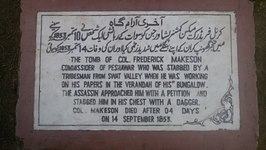Frederick Mackeson
Frederick Mackeson | |
|---|---|
| Born | 2 September 1807 Second Anglo-Sikh War |
Life
He was born in
In 1838, he was sent to
During the
In 1850,
Mackeson returned to India in 1851, and being then senior captain of his regiment and a brevet Lieutenant-Colonel, he was appointed Deputy Commissioner at Peshawar. For the next two years Mackeson was asked to pacify the frontier tribes, amid fears that subversive
On 10 September 1853 while listening to appeals in his veranda, he was greeted with a low salaam and presented with a piece of paper by a religious fanatic from Swat who proceeded to stab him with a large knife.[14][15] Mackeson died four days later on 14 September 1853.[16] It was generally understood that a price had been set on Mackeson's head, although the government denied that was the case.[citation needed] His assassin was tried, and on 1 October 1853 was hanged. By the advice of John Lawrence the murderer's body was burned after it was cut down, and the ashes thrown into a running stream.[17]


Legacy
Frederick Mackeson was buried in Khalid Bin Waleed Garden in Peshawar. A monument was erected in his memory within the Peshawar Cantonment paid for by his friends.[18]
The lasting legacy of Mackeson's influence around Peshawar can be noted by the words of Robert Warburton, himself a frontiersmen in the region over twenty five years later:[19]
"Wherever I have been, in every part of the Peshawar district, in the Khyber range, the name of Mackeson has been honoured and respected by all the residents of those lands above that of any other Englishmen who has been on the Peshawar border."
There is a large memorial plaque in Canterbury Cathedral, "erected to his memory by his friends and admirers in India".
He was known by locals by the name Kishin Kaka – Kishin being a corruption of his surname Mackeson.[20]
See also
References
- ^ Buckland, C.E., Dictionary of Indian Biography. London, 1906
- ^ George Bellas GREENOUGH, Address to the Royal Geographical Society of London delivered at the Anniversary meeting on the 27th May, 1840. By G. B. G., President, 1840, page 15
- ^ Earl Frederick Sleigh Roberts Roberts, Forty-one Years in India: From Subaltern to Commander-in-chief, Asian Educational Services, 1897, page 14
- ^ Charles Allen, Soldier Sahibs: The Men Who Made the North-West Frontier, Hachette UK, 21 June 2012
- ^ Buckland, C.E., Dictionary of Indian Biography. London, 1906
- ^ Charles Allen, Soldier Sahibs: The Men Who Made the North-West Frontier, Hachette UK, 21 June 2012
- R. Bosworth Smith, Life of Lord Lawrence, i. 412-13
- ^ Leavitt, Trow, & Company, 1853, The Eclectic Magazine of Foreign Literature, Science, and Art, Volume 28, University of Iowa,p.15
- ^ William Dalrymple, Anita Anand, William Dalrymple, Anita Anand, Bloomsbury Publishing USA, 12 September 2017
- ^ William Dalrymple, Anita Anand, William Dalrymple, Anita Anand, Bloomsbury Publishing USA, 12 September 2017
- ^ Jules Stewart, The Savage Border: The Story of the North-West Frontier, The History Press, 22 February 2007
- ^ Jules Stewart, The Savage Border: The Story of the North-West Frontier, The History Press, 22 February 2007
- ^ Jules Stewart, The Savage Border: The Story of the North-West Frontier, The History Press, 22 February 2007
- ^ Jules Stewart, Khyber Rifles, The History Press, 22 June 2006
- ^ Tejwant Singh, The Bold Brave and Fearless, Trafford Publishing, 2003, page 155
- ^ Earl Frederick Sleigh Roberts Roberts, Forty-one Years in India: From Subaltern to Commander-in-chief, Asian Educational Services, 1897, page 15
- ^ Earl Frederick Sleigh Roberts Roberts, Forty-one Years in India: From Subaltern to Commander-in-chief, Asian Educational Services, 1897, page 15
- ^ Earl Frederick Sleigh Roberts Roberts, Forty-one Years in India: From Subaltern to Commander-in-chief, Asian Educational Services, 1897, page 15
- ^ Jules Stewart, Khyber Rifles, The History Press, 22 June 2006
- ^ Charles Allen, Soldier Sahibs: The Men Who Made the North-West Frontier, Hachette UK, 21 June 2012
